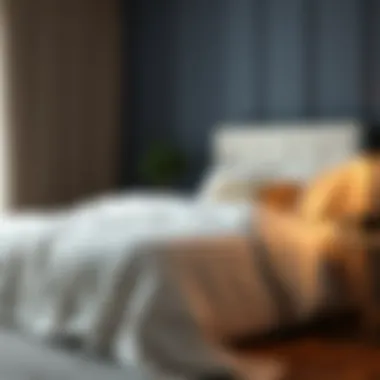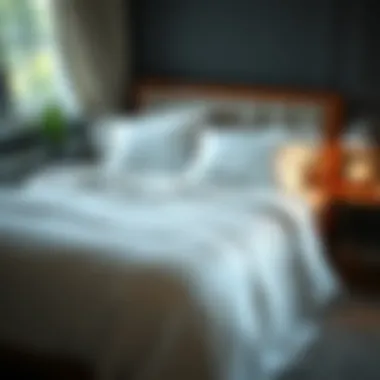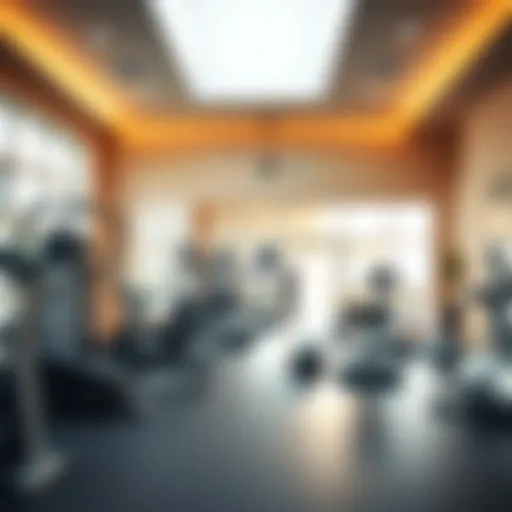Measurements of a Queen Fitted Sheet Explained


Intro
When it comes to selecting the right bedding, homeowners and designers often find themselves navigating through a labyrinth of options, particularly when it comes to queen fitted sheets. The right measurements not only ensure a snug fit on the mattress but also enhance the overall aesthetic of the bedroom. With the market chock-full of varying depths, fabric types, and dimensions, understanding these specifics is crucial for making informed decisions.
The queen fitted sheet is a staple in many households, serving as the essential layer between the mattress and any additional bedding. Unlike its flat sheet counterpart, the fitted sheet's primary function is to hug the mattress securely, preventing it from slipping or bunching. Hence, getting accurate measurements is paramount. This guide aims to demystify the nuances of queen fitted sheets, addressing the standard dimensions, the influence of fabric choices, and the critical factors affecting fit and comfort.
Moreover, we will dip into the maintenance aspects of these sheets, ensuring they not only look good but also last longer. By the end of this guide, readers should be armed with the knowledge necessary to select fitted sheets that align perfectly with their individual needs, contributing significantly to a comfortable night's sleep.
In the upcoming sections, we'll cover everything from the evolution of bedding styles, trends in materials, and practical tips for ensuring that your fitted sheet fits like a glove. Let's get started!
Understanding the Dimensions of a Queen Fitted Sheet
Knowing the dimensions of a queen fitted sheet is crucial for anyone looking to enhance their sleeping experience. If you've ever wrestled with a fitted sheet that just won’t stay in place, you’ll understand why this topic is important. The right measurements not only ensure a snug fit on your mattress but also contribute to overall comfort and sleep quality. Missing these details can lead to an unfriendly bedding situation, where sheets bunch up awkwardly or slip off during the night.
Let’s break down what you need to know about fitted sheets, starting with the standard measurements.
Standard Measurements
Typically, a queen fitted sheet comes in dimensions of 60 inches wide by 80 inches long. This is what most retailers follow when it comes to standard sizes. However, not all fitted sheets are created equal. One of the crucial factors that determine how well the sheet fits is the pocket depth. Standard sheets often come with a 12-inch pocket depth, but many consumers have noted that some mattresses are thicker, leading to a mismatch in sheet size. That being said, it’s essential to check the measurements of your mattress to select the right fitted sheet.
Here are the fundamental standards for a queen fitted sheet:
- Width: 60 inches
- Length: 80 inches
- Standard pocket depth: 12 inches
Variations in Fitted Sheet Depth
When we talk about depth, it doesn't just stop at the standard measurements. Many mattresses today, especially premium brands, have varying thicknesses due to additional comfort layers or pillow tops, raising the need for different depth sheets.
- Standard Pocket: Usually designed for mattresses up to 12 inches thick, these sheets are fine for basic foam and innerspring mattresses.
- Deep Pocket: Ideal for thicker mattresses, deep pocket sheets can accommodate depths ranging anywhere from 13 to 17 inches. If you’ve got a plush mattress, opting for value-added comfort with deep pocket sheets might be the way to go.
- Extra Deep Pocket: These are designed for mattresses that exceed 17 inches of thickness. They ensure a complete wrap-around fit, preventing any chance of slippage.
Regional Variations in Sizes
It’s not uncommon for bedding sizes to differ, depending on the region. While the queen size is fairly standardized in the United States, places like Europe or Asia have their own idiosyncrasies when it comes to mattress and bedding dimensions. For instance, in the UK, a similar size is called a "king" size mattress and measures 60 inches by 78 inches. In Australia, the queen size is still 60 x 80 inches, but the naming may differ. This can be really confusing if you’re purchasing international bedding!
It's wise to remain aware of these variations, especially if you’re browsing websites that ship from abroad. Always double-check product specs to avoid any mishaps.
"Understanding the dimensions and nuances of bedding options can lead you to make better purchasing decisions, ensuring your queen fitted sheet fits just right."
By grasping the essential aspects of queen fitted sheet measurements—standard sizes, depth variations, and international standards—you can sidestep potential regrets or uncomfortable nights. Stay tuned for the next sections where we’ll explore more factors that affect the fit and comfort of your fitted sheet.
Factors Affecting the Fit of a Queen Fitted Sheet
When it comes to achieving a cozy and snug bed, picking the right queen fitted sheet isn't just about the color or pattern. Understanding the underlying factors that dictate how well a fitted sheet fits is paramount for your overall comfort. This section delves into critical elements such as mattress thickness, type, and the elasticity of the material. Recognizing these factors ensures that you don’t end up wrestling with your sheets nightly.
Mattress Thickness
Mattress thickness directly influences the fit of your fitted sheet. Standard queen mattresses typically range from 9 to 12 inches thick. However, some may choose thicker options or even pillow-top mattresses that surpass 14 inches in depth. For a fitted sheet to do its job effectively, it should correspond with the mattress thickness. This is pivotal since a sheet designed for a thinner mattress will likely slide off on a thicker one, leaving you with a messy bed.
- Importance of Matching Thickness: A great fit enhances sleep quality. Sheets that are too tight can cause uncomfortable bunching, while those too loose might end up crumpled at the foot of the bed.
- Investing in Depth Variations: Some brands offer deep-pocket sheets specifically designed for thicker mattresses. Checking the listed depth on the product details can guide you to the right choice.
Mattress Type
The type of mattress you have also plays a considerable role in determining the correct fitted sheet. Not all mattresses are made equal—memory foam, latex, and traditional innerspring mattresses have distinct characteristics that can influence how a fitted sheet fits.
- Memory Foam and Latex: These types are typically denser than innerspring mattresses. When selecting a fitted sheet, consider a model that features extra elasticity, which can accommodate the contour of the mattress better.
- Innerspring Mattresses: Generally, these beds provide a flatter surface. Standard pocket sheets usually suffice if your mattress is of average thickness.
Understanding your mattress type may help in avoiding a poor fit that could disrupt your sleeping patterns.


Elasticity and Material Considerations
The fabric and design of a fitted sheet impact how well it stretches over your mattress. Elasticity is vital, as sheets that lack sufficient stretch are apt to come undone with even the slightest movement.
- Types of Material: Cotton, polyester, and blends all exhibit varying degrees of stretch. Cotton sheets often yield a softer touch, while polyester blends can sometimes be more durable and resistant to wrinkling.
- Comparing Edging Styles: Sheets with all-around elastic tend to grip the mattress better, which is favorable for active sleepers. In contrast, those with only corner elastic might not stay in place as effectively.
In summary, the nuances of mattress thickness, type, and the material utilized in making fitted sheets are all critical to achieving that perfect fit. A balanced combination can lead to better sleep hygiene and a more aesthetically pleasing bed. By taking the time to consider these elements before purchase, you surround yourself with a more conducive sleep environment.
"Investing time in understanding your bedding can significantly enhance your sleep experience. It’s not just about looks, but the fit and comfort too."
Sources to explore further:
Understanding these key factors will empower you to make informed decisions that enhance both comfort and style in your bedroom.
Popular Fabric Options for Queen Fitted Sheets
When it comes to choosing the right fitted sheet for a queen-sized mattress, one cannot overlook the fabric options available. The fabric not only adds aesthetic appeal but also influences the overall comfort, durability, and care requirements of your bed linens. Each type of material comes with benefits and limitations, which ultimately impacts your sleeping experience. Understanding these fabric options ensures that homeowners, interior designers, and retail professionals can make informed decisions for superior quality sleep.
Cotton Variants
Cotton is commonly considered the gold standard when it comes to bedding fabrics. It's breathable and hypoallergenic, making it a top choice for many. Within the realm of cotton, there are several variants worth discussing:
- Egyptian Cotton: Known for its long fibers, Egyptian cotton is exceptionally soft and durable. It feels luxurious against the skin, offering both strength and a smooth texture. For mattresses that are used frequently, this can be a practical option that withstands regular washing.
- Pima Cotton: Similar to Egyptian cotton, Pima comes with a silky finish and superior color retention. This cotton type is also gentler on sensitive skin, which is an essential consideration if you're prone to allergies or skin irritations.
- Upland Cotton: The most widely used cotton in the textile industry, Upland is more cost-effective but less soft than its premium counterparts. It’s still a viable option for folks looking for affordability without sacrificing quality too much. In this day and age, it’s easy to find varying qualities across this type, so shopping for a trusted brand is key.
Choosing the correct cotton variant can significantly enhance your sleeping experience, ensuring that the sheet not only fits but feels right, too.
Blends and Synthetics
In recent years, blends and synthetic fabrics have gained traction in the bedding market for their unique characteristics and affordability. Blends, such as cotton-polyester, combine the best of both worlds, offering durability and easy maintenance. Here are some notable features:
- Cost-Effectiveness: Blended fabrics tend to be cheaper than all-cotton options. This makes them attractive to budget-conscious consumers who still desire comfort and style.
- Wrinkle and Stain Resilience: Compared to pure cotton, blends resist wrinkles better and are easier to clean. This is particularly helpful for those with busy lifestyles or families.
- Breathability: While synthetic materials like polyester tend to trap heat, blending them with cotton can help retain breathability without sacrificing structure or fit.
It's also worth mentioning materials like microfiber, which are synthetic and exceptionally soft. They can mimic the plush feel of down, providing a different type of comfort not found in traditional woven fabrics. However, one should be wary of heat retention if this is a primary concern for sleep quality.
Luxury Fabrics: Silk and Linen
For those seeking the pinnacle of luxury in bedroom decor, silk and linen present unmatched elegance and comfort. Their unique properties offer a personalized sleeping experience that many find difficult to replicate with standard fabrics.
- Silk: Luxurious to the touch, silk sheets are incredibly smooth, which can be soothing for those experiencing skin sensitivities. Additionally, silk is temperature-regulating, keeping you cool in summer and warm in winter. Yet, one needs to be cautious as silk can be quite delicate, often requiring specific care to avoid damage.
- Linen: On the other hand, linen's robust structure brings a naturally textured appearance. Renowned for its breathability, linen is a superb choice for those who sweat during the night. Its durability is notable, as linen sheets can last for years if cared for properly. The slight wrinkling of linen also contributes to its unique charm, appealing to those who appreciate a more casual, rustic look.
In summary, silk and linen provide distinctive attributes that cater to varying consumer preferences, ranging from luxury to practicality. By selecting the appropriate fabric, one can dramatically elevate the quality of their bedding, making it a worthwhile investment in personal comfort and style.
Selecting the right fabric is just as crucial as ensuring correct measurements. Invest time and thought into your choices, and you'll reap the ultimate rewards in sleep quality and satisfaction.
Measuring your Mattress for the Perfect Fit
Getting a queen fitted sheet that fits snugly can feel like searching for a needle in a haystack. But, here’s the kicker—measuring your mattress properly is vital. Not only does it ensure comfort, it also impacts how well the sheet hugs your mattress, thus enhancing your sleep quality. After all, there’s nothing worse than waking up to a wrinkly sheet that has slipped off halfway through the night. Let's dive deeper into this essential topic and guide you through accurate measurement since every detail matters when it comes to your bedding.
Tools Required for Accurate Measurement
Before diving into the dimensions, you need a couple of reliable tools. Here's what you should have on hand:
- Measuring Tape: A flexible measuring tape works best. The retractable type can be handy too, but the soft tape lets you measure contours easily.
- Notepad and Pen: Keeping track of your measurements helps avoid confusion. Jotting them down also prevents you from having to repeat the process.
- Straight Edge or Ruler: This helps in measuring the mattress depth accurately.
- Calculator: If you're not great with numbers, a simple calculator can make things easier, particularly when converting measurements from inches to centimeters or vice versa.
Having these tools ready sets you up for success.


Step-by-Step Measurement Guide
Measuring your mattress might seem like a piece of cake, but one slip-up can throw off your whole bedding experience. Here’s how to get it right, step by step:
- Measure the Length: Start by measuring the length of the mattress. Lay the measuring tape from the head of the mattress to the foot. A standard queen mattress measures about 80 inches long.
- Measure the Width: Next, measure the width. Again, lay the tape horizontally across the mattress. A queen typically measures around 60 inches wide.
- Measure the Depth: For depth, you might need to get a little clever. Use the straight edge or ruler and place it flush against the side of the mattress. Measure from the base to the top of the mattress. Depth can vary quite a bit, often ranging from 8 to 14 inches, or more for pillow-top mattresses.
- Record Your Measurements: Don’t forget your notepad; write down every measurement clearly. This step can save you from purchasing mismatched sheets.
- Double Check: Just a gentle nudge, always double-check your measurements. It’s easy to misplace a tape or miscalculate a depth.
This method gives you a complete picture, ensuring you have all the right numbers at hand when shopping.
Common Measurement Mistakes to Avoid
Even seasoned DIYers can trip up now and then. Here are some pitfalls to watch for when measuring your mattress:
- Not Measuring Every Dimension: People often forget to check the depth, which can lead to purchasing sheets that don’t fit. Always remember that dimensions come in three sizes: length, width, and depth.
- Assuming Standard Sizes: Not every queen mattress fits traditional measurements. Variations in manufacturing can lead to discrepancies. If you have a custom mattress or a specialized design, verify its measurements.
- Not Including Mattress Topper: If you use a mattress topper, factor in its thickness during your depth measurement. It can significantly alter the fit of your sheet.
- Ignoring Shape Variations: Some mattresses have rounded corners or unique profiles. Measure carefully along the contours to avoid surprises.
By steering clear of these common mistakes, you can ensure a much smoother shopping experience.
Ensuring that you measure your mattress accurately is indispensable. These steps and tips equip you with the knowledge to choose the right fitted sheet, enhancing your sleep quality and bedroom aesthetics. Don't underestimate the importance of fitting your mattress like a glove—it's a game changer.
Understanding the Importance of Proper Fit
When it comes to your sleep environment, the fit of your fitted sheet plays a critical role in both comfort and aesthetics. A well-fitting queen fitted sheet can transform your bed from merely a place to sleep into a sanctuary of relaxation. Proper fit affects not just how the sheet looks, but how it feels and even how long it lasts.
Impacts on Sleep Quality
A fitted sheet that is tailor-made for your mattress dimensions can vastly improve your sleep experience. First and foremost, if a sheet is too loose, you may find yourself waking up in the middle of the night, wrestling with tucks and folds beneath you. Conversely, a sheet that is too tight could restrict movement, leading to discomfort.
A consistent tension across the entire surface of the fitted sheet allows for proper airflow and temperature regulation at night. This is especially important for those who may experience night sweats or general discomfort due to heat retention. Choose the right size so you can sleep soundly without interruptions.
"Sleep is the golden chain that ties health and our bodies together."
Aesthetic Considerations for Bedrooms
The right fit isn’t merely a matter of functionality; it also enhances the visual appeal of your bedroom. A fitted sheet that smoothly conforms to your mattress creates a polished look, giving your bed the kind of neatness that becomes a focal point of the room. This effect is even more pronounced when one takes into account the type of fabric and patterns.
Here are a couple of aesthetic elements worth noting:
- Color Harmony: A well-fitted sheet acts as a canvas for other decorative elements—duvets, throws, and pillows all take cues from the fitted sheet's color.
- Texture: The feel of a fitted sheet against the skin can influence how cozy a bedroom seems. High-quality materials can elevate the room's atmosphere, making it visually inviting and physically comforting.
Longevity of Bedding
The durability of bed linens is fundamentally tied to the way they fit the mattress. A fitted sheet that is neither too tight nor too loose is less likely to experience wear and tear over time. Sheets that bunch up or pull too tightly can easily fray, leading to a shorter lifespan of your investment.
Maintaining a good fit also makes it easier to care for your sheets. They can withstand repeated washings without losing their shape or structure, making them last longer. This is not just a financial consideration but also speaks to sustainability; fewer purchases mean less waste.
Investing in a quality fitted sheet that fits well will save time and money in the long run, making it a sensible choice for anyone looking to build a restful sleeping space.
Choosing the Right Style of Fitted Sheet
Selecting the appropriate style of a fitted sheet can dramatically affect your sleep experience and the overall look of your bedroom. It seems trivial, but the right choice ensures not only the best fit but also enhances comfort, aesthetics, and durability. Many people overlook these details, but understanding various styles can make all the difference when it comes to a good night's sleep.
Deep Pocket vs. Standard Pocket
When you’re shopping for fitted sheets, one of the first styles you'll encounter is the distinction between deep pocket and standard pocket sheets. A standard pocket sheet typically fits mattresses up to about 12 inches in depth, while deep pocket sheets accommodate thicker mattresses that can reach 16 inches or more.
Consider the mattress type you own before making a choice.
Older mattresses and many innerspring models tend to have slimmer profiles, so standard pocket sheets may suffice. Conversely, if you possess a plush pillow-top or a memory foam mattress, deep pocket sheets would be more suitable to ensure that they stay snugly in place.
In addition, you’ll want to take into account any additional layers, such as mattress toppers, that can impact how well your sheet fits. If your bedding setup is a bit on the thicker side, don’t compromise; opt for deep pocket sheets that allow for ample fit and eliminate unsightly bulges or slippage.


Types of Corner Construction
Another vital aspect of fitted sheet styles is corner construction—essentially, how the corners of the sheets are designed to hold the fabric securely around the mattress. Typical corner styles include pocketed corners and elasticized corners.
- Pocketed Corners:
These are designed to wrap snugly over the corners of your mattress. They hug each corner well and provide a more tailored look. This option is particularly beneficial for heavier individuals or for those who move around a lot during sleep. - Elasticized Corners:
Elasticized sheets have elastic all the way around the fitted edge. This gives them the ability to stretch and adjust to varying mattress shapes without losing grip.
If you prefer sheets that are easy to put on and take off or if you frequently wash your bedding, consider sheets with elasticized corners. They tend to be more user-friendly and adaptable.
Choosing Between Elastic and Non-Elastic Edges
The choice between elastic and non-elastic edges can directly impact how well your fitted sheet stays in place. Elastic edges are standard in most fitted sheets today, providing flexibility. However, some people prefer sheets with a more rigid, non-elastic finish.
- Elastic Edges:Benefits include:
- Non-Elastic Edges:While less common, these can sometimes lend a more sophisticated touch, which may appeal to design-conscious homeowners. However, they may lack the flexibility seen in elastic constructed sheets and could require more effort to perfectly position.
- Better Fit: They help maintain a snug fit throughout the night, preventing the sheet from slipping off.
- Easy to Adjust: Quick to secure around the mattress, making bed-making simple.
Any decision should rest on personal preference, mattress type, and how much movement you typically experience while sleeping.
Care and Maintenance of Your Fitted Sheet
Caring for your queen fitted sheet is crucial for maintaining not only its appearance but also its overall lifespan and comfort. Regular maintenance helps to ensure that your bedding remains fresh, hygienic, and inviting. It’s not just about keeping things neat and tidy; understanding proper care can enhance the textiles' fabric properties and prolong the life of your investment.
When considering fitted sheets, an often overlooked aspect is how cleaning, drying, and storage can influence the fabric's durability and feel. Ignoring these can lead to wear and tear, fading colors, or even a decline in comfort. Let's explore essential elements involved in the care and maintenance of your fitted sheet.
Washing Instructions
When it comes to washing your fitted sheet, there are a few key guidelines that can help you prevent damage and maintain its quality. It's best to check the manufacturer's label for specific washing instructions; however, some general rules apply:
- Water Temperature: Using cold or warm water is typically best to preserve colors and prevent shrinkage. Hot water may clean better but can also set stains and wear out fabrics.
- Detergent: Choose a mild detergent. Harsh chemicals can degrade fabric integrity over time.
- Washing Method: If you're using a washing machine, a gentle cycle is optimal. For delicate fabrics, hand washing may even be an option worth considering.
- Frequency: Aim to wash your sheets every one to two weeks, depending on personal usage and allergies. It prevents the buildup of dirt and sweat, maintaining a cleaner sleeping environment.
By keeping these tips in mind, you help ensure your fitted sheet remains soft, vibrant, and comfortable.
Drying Methods
Drying your fitted sheet correctly is just as important as washing it. Here are some methods to consider:
- Air Drying: The natural way to dry—hanging your sheets outside can give them a fresh scent while avoiding the heat of a dryer. Just be cautious about direct sunlight, as UV rays can fade colors.
- Tumble Drying: If you opt for a dryer, use a low heat setting to avoid damaging fabric fibers. Also, remove the sheets promptly to reduce wrinkles.
- Dryer Balls: Using dryer balls can help fluff your sheets while drying, keeping them softer and preventing clumping.
Each of these methods has its pros and cons, so the choice may depend on factors like time and convenience versus optimal fabric care.
Storage Tips
Once your fitted sheets are cleaned and dried, proper storage is essential to keep them looking and feeling their best:
- Fold Neatly: Fold your sheets properly to minimize wrinkles. A bit of effort here pays off when you grab them from the closet.
- Avoid Overcrowding: Store your sheets in a cool, dry place. Too many sheets jammed together can create creases and lead to musty odors, particularly in humid areas.
- Use Breathable Storage Bags: If you’re tucking away seasonal sheets, consider breathable cotton bags. These can help keep the fabric fresh and moisture-free over time.
Following these simple guidelines ensures that your fitted sheets not only feel great every time you use them but also last considerably longer. In the end, proper care translates to comfort, longevity and a better night’s sleep.
Finale
In wrapping up the discussion on the measurements of a queen fitted sheet, several important factors stand out, significantly contributing to informed choices in bedding. Understanding not just the standard dimensions but also variations in depth and fabric options can profoundly affect sleep quality, aesthetics, and long-term satisfaction with bedding purchases.
Recap of Key Points
To summarize, here are the key elements covered in this guide:
- Standard Measurements: A queen fitted sheet generally measures 60 x 80 inches, but different considerations like depth and fabric can alter how well it fits your mattress.
- Variations in Depth: Knowing the depth of your mattress is crucial, as it can range from 6 inches to over 18 inches. This affects the type of fitted sheet you might need, leading to better comfort and usability.
- Materials Matter: Cotton, blends, and luxury fabrics each have their own set of properties that impact not just feel and look, but also durability and care requirements.
- Proper Care: Regular maintenance includes washing at the right temperatures and using suitable drying methods, which can extend the lifespan of your fitted sheets and keep them looking fresh.
- Choosing Style: Different styles and constructions allow for customization in how a sheet fits a mattress, enhancing both comfort and functionality.
Final Recommendations
When it comes to selecting a queen fitted sheet, here are some pointers:
- Measure Twice, Buy Once: Before making a purchase, accurately measure your mattress for length, width, and depth. Double-checking these dimensions against product specifications can save you considerable time and trouble.
- Consider Material: Choose fabric based on personal preference and sleep needs. If you tend to sleep warm, cotton or moisture-wicking blends might be ideal, while luxury fabrics can offer a plush feel at a higher cost.
- Quality Over Quantity: Rather than accumulating multiple sheets, invest in a few well-made options that withstand frequent use and laundering. This is more economical in the long run and enhances the quality of your sleep environment.
- Stay Informed: Keep abreast of trends and advancements in bedding technology that might improve your sleep experience. Understanding what's available can make a tremendous difference in finding the perfect fit for your needs.
In essence, a tailored approach to selecting your queen fitted sheet not only improves night-time comfort but also adds an element of chicness to your bedroom decor. Take the time to understand the nuances of fit, fabric, and maintenance—your sleep quality might just thank you.















